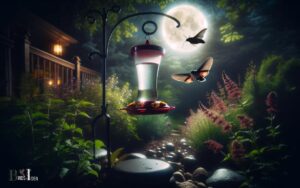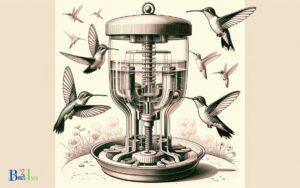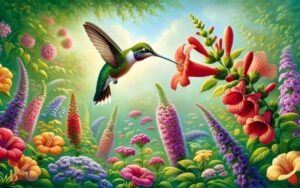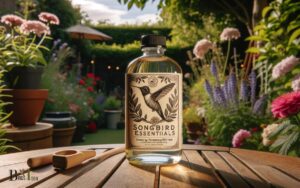How Much Does a Hummingbird Eat? Find Out!
Hummingbirds consume half their body weight in sugar daily, primarily from nectar, and they also eat insects and spiders for protein.
They may feed 5-8 times per hour, with each feeding session lasting around 30 seconds to a minute.
The diet of a hummingbird is predominantly made up of nectar, which provides the necessary sugars for energy.
The exact amount a hummingbird eats can depend on various factors such as species, size, activity level, and the availability of food sources.
Typically, they need to consume a substantial amount of nectar to support their high metabolism. Insects and spiders are also crucial for their diet, supplying protein, vitamins, and minerals.
A hummingbird’s diet is a finely tuned balance of sugar and protein, essential for sustaining its energetic lifestyle.
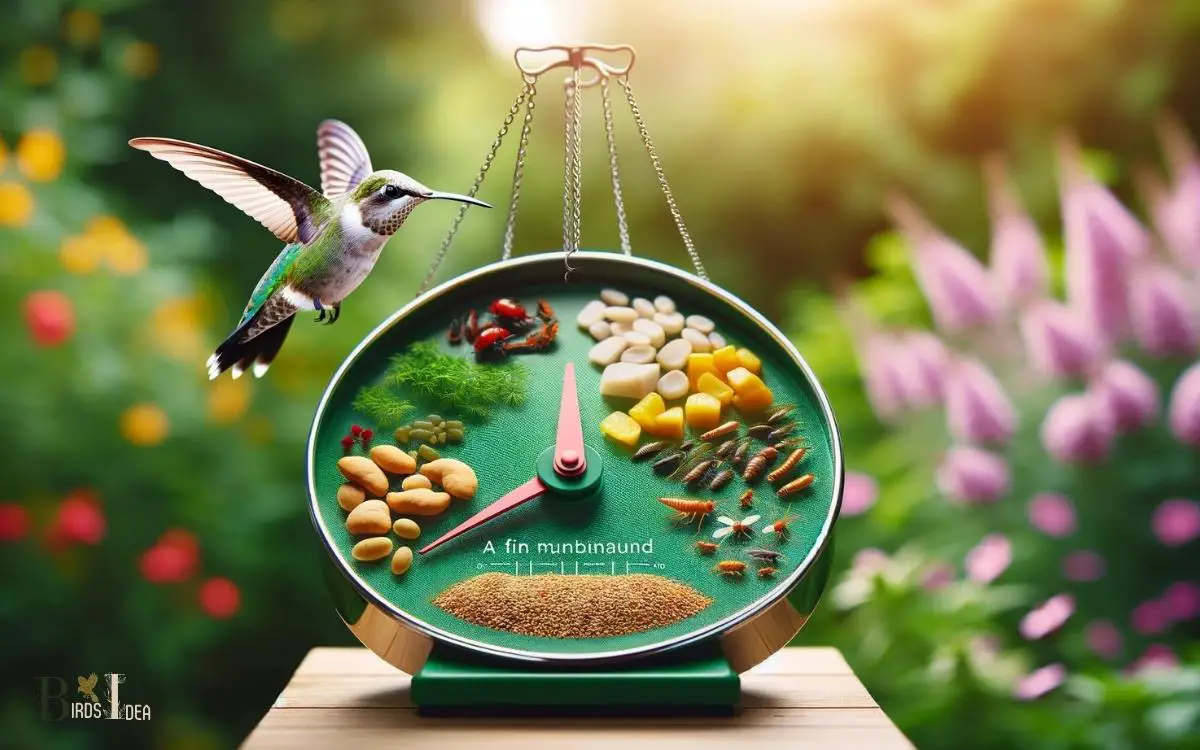
Key Takeaway
The Diet of a Hummingbird
Hummingbirds frequently consume nectar, insects, and spiders as their primary sources of nutrition.
Their high metabolism requires them to feed every 10 to 15 minutes, leading them to consume half their body weight in food each day.
This means that they need to visit hundreds of flowers to meet their energy demands. By consuming nectar, these tiny birds play a vital role in pollination, inadvertently aiding in the reproduction of flowering plants.
Insects and spiders provide essential protein and other nutrients necessary for their survival, especially during the breeding season.
The diet of a hummingbird is finely tuned to support their intense energy needs, making them remarkable creatures to observe and care for.
Now, let’s delve into the specifics of nectar consumption by these fascinating birds.
Nectar Consumption
How extensively do hummingbirds consume nectar to meet their high energy demands and nutritional requirements?
Hummingbirds have a remarkable ability to consume nectar, often visiting hundreds of flowers in a single day to fuel their high metabolism.
Their nectar consumption is substantial, with some species consuming up to twice their body weight in nectar each day.
This high intake is necessary to sustain their rapid wingbeats, which can exceed 50 times per second, and to support their constant search for food.
Hummingbirds have a specialized tongue adapted for efficient nectar collection, allowing them to extract as much nectar as possible from each flower.
They have a keen sense of memory, enabling them to remember the locations of the flowers they have recently visited.
Moving on to the subsequent section about ‘insect intake’
Insect Intake
The consumption of insects by hummingbirds supplements their diet with essential proteins and fats, contributing to their overall nutritional needs.
Hummingbirds are known to be voracious insect-eaters, and their diet heavily relies on these small creatures to meet their high energy demands.
Insects provide vital nutrients such as amino acids, vitamins, and minerals, which are crucial for the hummingbird’s growth, development, and maintenance of bodily functions.
Below is a table showcasing the types of insects commonly consumed by hummingbirds:
| Type of Insect | Nutritional Content |
|---|---|
| Gnats | High in protein |
| Aphids | Rich in fats |
| Mosquitoes | Contains essential vitamins |
| Fruit Flies | Good source of minerals |
| Caterpillars | Provides amino acids |
Understanding the significance of insect intake in a hummingbird’s diet is essential for creating environments that support their nutritional needs.
Daily Feeding Habits
When considering the daily feeding habits of hummingbirds, it becomes apparent that their high metabolism necessitates frequent feeding intervals. Understanding their feeding habits is crucial for those who desire to serve these tiny birds.
Here are the daily feeding habits of hummingbirds:
- Frequency: Hummingbirds feed approximately 5-8 times per hour, with some species consuming up to half their body weight in food each day.
- Time of day: They are most active during the early morning and late afternoon, coinciding with the peak times for flower nectar production.
- Portion size: A single feeding session typically lasts for about 30-60 seconds, during which they consume small amounts of nectar or insects.
- Feeding territories: Hummingbirds fiercely defend their feeding territories, ensuring a consistent food supply and allowing them to serve their own nutritional needs.
Food Intake in Relation to Body Size
In relation to their body size, hummingbirds consume a remarkable amount of food each day to sustain their high metabolism and energetic lifestyle.
Despite being the smallest birds, their food intake is substantial. Hummingbirds have a fast metabolism, with some species needing to consume up to 3 times their body weight in nectar and insects daily.
This high food intake is essential for fueling their rapid wing beats, hovering flight, and constant movement.
The energy they expend is proportional to their body size, making their feeding habits unique and fascinating.
Understanding this relationship between food intake and body size is crucial for anyone interested in serving these remarkable creatures, as it emphasizes the importance of providing abundant food sources to sustain their demanding lifestyle.
Feeder Usage and Frequency
Feeder usage and frequency are crucial factors in understanding the feeding habits of hummingbirds.
The frequency of feeder refills and the optimal feeding times play a significant role in the overall food intake of these tiny birds.
By exploring these points, we can gain valuable insights into how to best support the nutritional needs of hummingbirds.
Feeder Refill Frequency
Hummingbirds regularly consume nectar from feeders, requiring frequent refillings to ensure a consistent food supply. Maintaining a regular refill schedule is crucial for the well-being of these tiny birds.
Here are some important considerations for feeder refill frequency:
- Weather Conditions: Warmer temperatures can cause nectar to spoil more quickly, necessitating more frequent refills during hot days.
- Feeder Size: Larger feeders can hold more nectar, allowing for longer intervals between refills compared to smaller feeders.
- Hummingbird Population: A higher number of hummingbirds visiting the feeder will deplete the nectar faster, requiring more frequent refills.
- Time of Year: During migration or breeding seasons, hummingbirds may consume more nectar, requiring increased refill frequency.
Optimal Feeding Times
When considering optimal feeding times for hummingbirds, it is important to take into account the factors influencing feeder usage and refill frequency.
Hummingbirds are most active during the early morning and late afternoon, making these the optimal times to ensure feeder availability.
Considering their high metabolic rate, it is crucial to maintain a consistent refill frequency, typically every 2-3 days, to meet their energy needs.
By understanding the natural feeding patterns of hummingbirds and their energy requirements, feeder usage can be optimized to best serve these remarkable creatures.
Providing a reliable food source during their peak feeding times ensures that they can obtain the necessary nutrients to sustain their energetic lifestyles.
Ultimately, by aligning feeder refills with their optimal feeding times, individuals can effectively support and serve the needs of these delightful birds.
Seasonal Variations in Food Consumption
As we explore the topic of hummingbird food consumption, it is essential to consider the seasonal variations that impact their feeding habits.
Factors such as food intake by season, the influence of weather conditions, and the impact of migration and diet play a crucial role in understanding the fluctuations in a hummingbird’s food consumption.
By examining these points, we can gain valuable insights into the dynamic nature of their dietary needs throughout the year.
Food Intake by Season
The food intake of hummingbirds varies significantly by season, leading to seasonal fluctuations in their overall consumption.
Understanding these variations can help those serving hummingbirds to provide the appropriate nourishment throughout the year.
Here’s a breakdown of their food intake by season:
- Spring: During the breeding season, hummingbirds increase their food intake to support the energy demands of nesting and raising young.
- Summer: As flowers bloom and insect populations increase, hummingbirds have access to a wider variety of food sources, resulting in a steady and abundant food supply.
- Fall: In preparation for migration, hummingbirds ramp up their food intake to build up fat reserves for the long journey ahead.
- Winter: With fewer food sources available, hummingbirds reduce their metabolism and enter a state of torpor to conserve energy during the colder months.
Impact of Weather
Hummingbirds’ food consumption fluctuates seasonally due to the impact of weather, leading to variations in their overall intake.
In warmer months, when flowers are in full bloom, hummingbirds have access to an abundance of nectar and insects, causing an increase in their food consumption to support their energy needs.
Conversely, in colder months or during droughts, food sources become scarce, leading to a decrease in their intake.
Hummingbirds have adapted to this fluctuation by adjusting their metabolism and behavior. During periods of food scarcity, they can enter a state of torpor to conserve energy.
Understanding these seasonal variations is crucial for those who desire to provide a hospitable environment for these tiny creatures. Now let’s delve into how migration impacts their diet.
Migration and Diet
Each year, hummingbirds undertake impressive long-distance migrations, impacting their diet and food consumption patterns throughout different regions.
During their migrations, hummingbirds adapt their diet to the availability of food sources in various locations.
This results in seasonal variations in their food consumption, influenced by the following factors:
- Flowering Seasons: Hummingbirds adjust their diet based on the blooming seasons of different flowers along their migration route.
- Insect Availability: They increase their consumption of insects in areas where floral nectar is scarce, providing essential protein and nutrients.
- Climate Changes: They adapt their diet according to the climate variations in different regions, altering their food consumption patterns accordingly.
- Energy Requirements: Hummingbirds modify their diet to meet their energy needs for long flights, consuming more food before and during migration.
What Does a Humming Bird Eat?
Hummingbirds primarily feed on nectar from flowers, which provides them with the energy they need for their high metabolism.
Nectar is a sweet liquid produced by flowers, and hummingbirds have specialized long bills and extendable, tube-like tongues that allow them to extract the nectar from deep within the flowers.
In addition to nectar, hummingbirds also consume small insects and spiders for protein. This is especially important during the breeding season when they need extra protein for egg development and feeding their young.
Hummingbirds are known for their agility and ability to catch insects in mid-air using their specialized bills.
To supplement their diet, hummingbirds may also drink tree sap, eat pollen, and consume sugar-rich solutions from artificial feeders provided by humans.
Many people hang hummingbird feeders filled with a solution of water and sugar to attract these small birds to their gardens.
It’s important to note that if you provide a hummingbird feeder, the sugar solution should be made with a ratio of about four parts water to one part white granulated sugar.
It’s not recommended to use honey or artificial sweeteners, as they can be harmful to hummingbirds. It’s crucial to keep the feeders clean to prevent the growth of harmful molds and bacteria.
How Much Should I Fill My Hummingbird Feeder?
Hummingbird feeders maintenance guide: Knowing how much to fill your hummingbird feeder is essential for their proper nourishment. Generally, it is recommended to fill the feeder halfway to prevent wastage and spoilage. Adjust the quantity based on bird activity and temperature to keep the nectar fresh and attractive to these delightful creatures.
What is a Hummingbird’s Favorite Food?
Hummingbirds primarily feed on nectar from flowers. Nectar is a sweet liquid that provides them with the energy they need for their high metabolism.
The hummingbird’s long, specialized bill and extendable, tube-like tongue are adapted for extracting nectar from deep within flowers.
In addition to nectar, hummingbirds also consume insects and spiders for protein. They may catch these in mid-air or gather them from flowers and spider webs.
To attract hummingbirds to your garden or yard, you can provide artificial nectar in hummingbird feeders.
The nectar solution typically consists of a mixture of water and white granulated sugar (about four parts water to one part sugar). It’s important to clean the feeders regularly to prevent the growth of harmful mold or bacteria.
Conclusion
The diet of a hummingbird consists of nectar and insects, with daily feeding habits and food intake varying based on body size and seasonal changes.
These tiny birds have high energy needs and rely on frequent feeding to sustain their active lifestyle. Like a well-oiled machine, their feeding habits keep them fueled and in constant motion.

